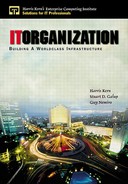Chapter 3. The CIO's Role
In this section we discuss the CIO's role as we enter the 21st century. Executives will have little choice but to start focusing at least 50 percent of their time to getting their house (infrastructure) in order. This is due to global competition, business requirements/issues, shrinking IT budgets, and unhappy customers. They will have no choice but to get involved. It's not too late.
How times have changed. The MIS managers in the 1970s and 1980s knew every aspect of their infrastructure. There were no surprises. They were very much in tune with their infrastructure, especially those people and process issues we discuss throughout the book. They let their system programmers and DBAs worry about the technology. Their biggest concern was RAS. The MIS managers of yesteryear were the ones responsible for providing us with high reliability, availability, and serviceability. IT wouldn't be what it is today without their relentless pursuit of RAS. We can learn from their experiences and the way they managed. They were involved, they spent time in the trenches with the enlisted. They knew exactly what was being done. They were credible leaders to their troops because they typically came up from the ranks and had established their expertise.
Today is a whole new ballgame. Yet, to be successful, they need to show the same leadership as their peers of the 1970s, and they need to set accountability standards.
Infrastructures are bending, bleeding, and becoming more costly than ever because everyone's supporting more disparate systems than ever before. Very little time is being focused on implementing key processes. Actually, the organization structure is so far off center that processes would not be effective in this environment.
CIOs everywhere have been focusing on new systems development and deployment because that's how they've been getting rewarded by their bosses and other peers in the executive ranks who believe that development is where they get the biggest bang for the buck. After all, it is the politically correct thing to do. The quicker new systems are deployed to meet the needs of the business, the easier it is for the CIO to gain peer respect in the short run. Unfortunately, the modus operandi does not encourage long-term planning.
What about the long-term impacts of continuously adding client/server information systems? If the new applications don't fit into the overall IT architecture, or don't have ample bandwidth or adequate support from the DBAs, they don't work. Believe us, we've seen too many examples of well-intended projects going amok because they were created in vacuums without consideration to the infrastructure required to support them.
